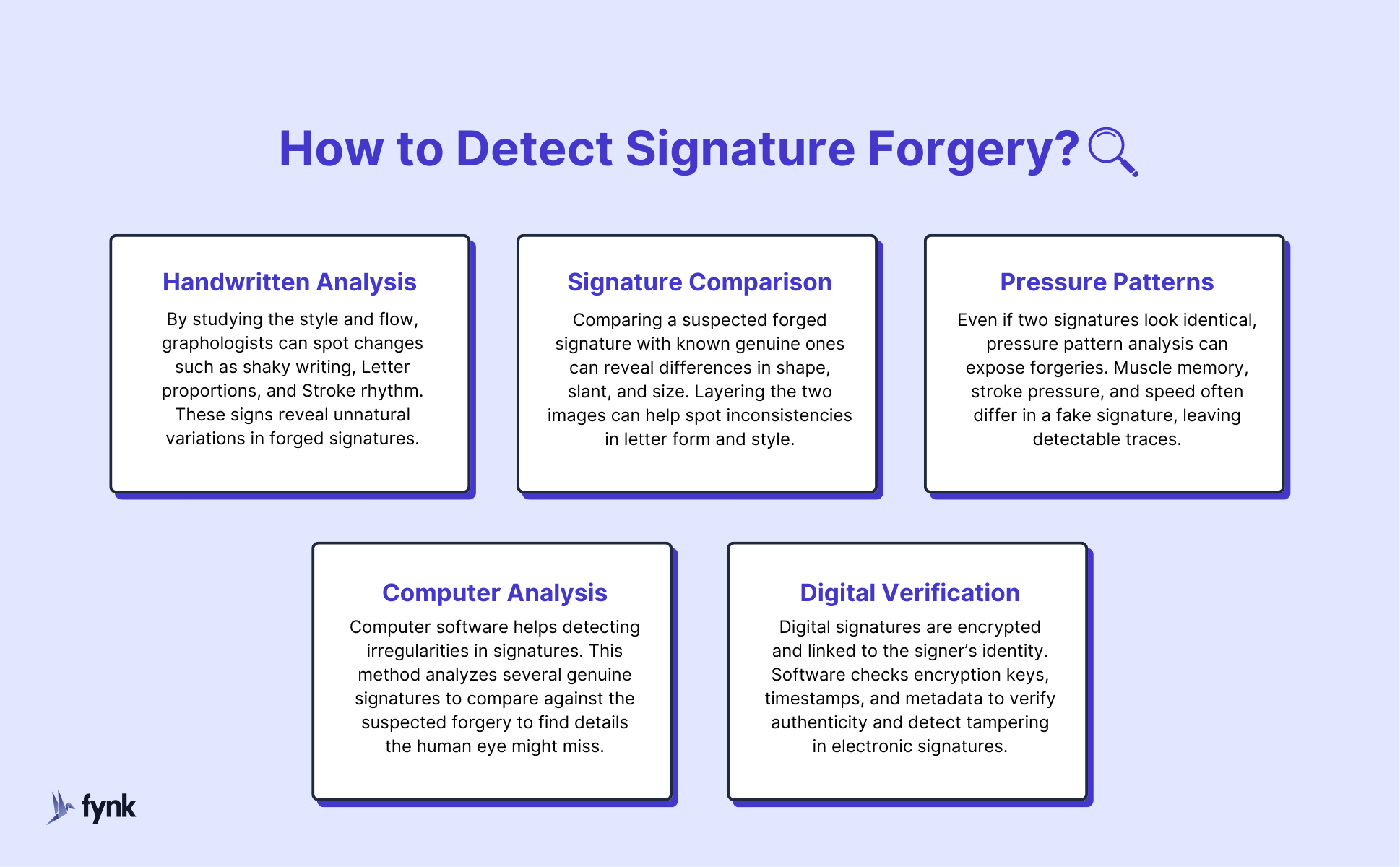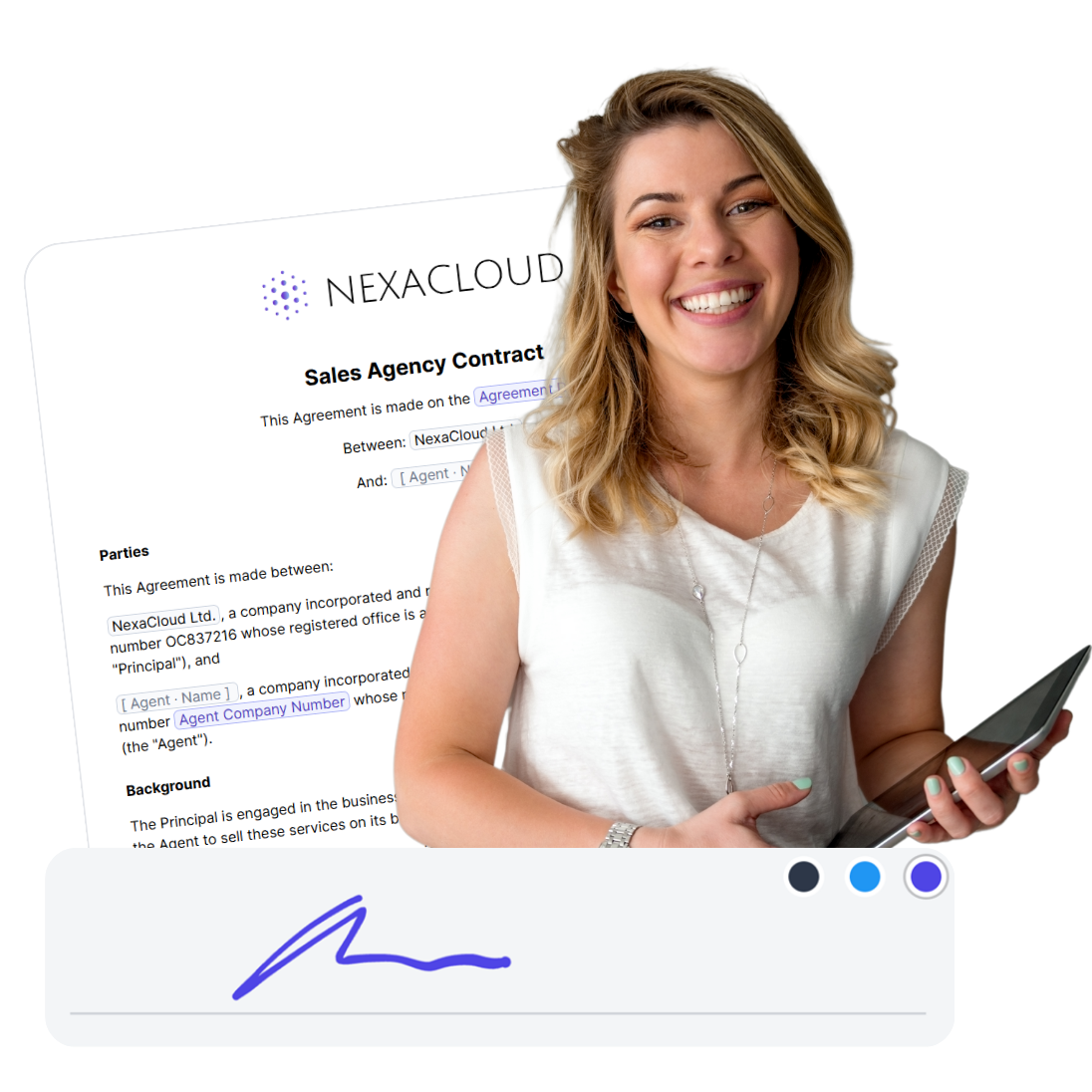Signature Forgery Explained - Types, Risks, and Protection Tips
Signature forgery is the unauthorized imitation or duplication of a person’s signature to commit illegal activities like fraud or identity theft. The forger may fake the signature on paper or digitally, often resulting in financial loss for the victims. This guide will explain the types of forgery, how to detect it, and ways to protect yourself from becoming a victim.
- 3 Types of Signature Forgery
- How to Detect a Signature Forgery?
- What Are the Common Consequences of Signature Forgery?
- What’s the Penalty for Signature Forgery?
- Best Practices to Prevent Signature Forgery
- What Should You Do If Someone Forges Your Signature?
- Signature Forgery VS Identity Theft: What are the Differences?
- Frequently Asked Questions

Signature forgery is a serious crime and can have heavy punishments like imprisonment and hefty fines, which in some cases, could go up to millions of dollars.
Forgery can harm victims not only financially, but also by damaging their reputation. That’s why it’s important for every professional to be aware of this illegal act, how to prevent and detect it before it gets out of hand.
3 Types of Signature Forgery
Signature forgeries can be in different shapes and formats, but they can be grouped into one of the following three categories:
1. Simple Forgery
Simple signature forgery is when someone signs freehand other people’s names they have no authority to use.
💡 Good to Know: Signing on behalf of someone, when properly authorized (such as through a power of attorney or written consent), is different and legal in many cases.
2. Handwritten (Simulation) Forgery
- Simulated Signature: When the forger imitates the handwritten signature (wet signature) of someone by practice to replicate the exact genuine signature.
- Tracing Signature forgery: When the signature is forged by placing the original signature under a thin blank sheet and tracing it to create a duplicate, making it appear authentic.
3. Digital Forgery
Forging a digital signature can be more complicated and comes in many different shapes including:
- Copy-paste forgery: Forgers use image editing software to copy the signature and paste it where they want to create an exact duplicate.
- Signature forgery software: Some apps allow forgers to create fake signatures by either tracing an original or digitally replicating it. They often have features like adjusting stroke pressure, speed, and style to mimic the nuances of the original signature. They can even trace the real copy using image recognition tech and replicate a person’s signature from a scanned document or photo.
- Autopen machines: These machines can duplicate both traditional wet signatures and electronic ones by replicating the signature’s shape, pressure, and style.
How to Detect a Signature Forgery?
But how to tell if a signature is forged? Especially if it’s forged electronically, when there seems to be no trace, at least in the appearance.
The definite evidence that proves a signature has been forged is called “The Smoking Gun.” The smoking gun is different from case to case and the type of method used, but here are the common ways you can use to find the smoking gun:


Handwritten Analysis (Graphology)
Almost like fingerprints, each person’s handwriting is unique. By analyzing the style, pressure, flow, and strokes of letters in the signature, you can spot inconsistencies. This is exactly how graphologists find unnatural variations when studying a forged signature.
Some of these inconsistencies are:
- Shaky handwriting
- Letter proportions
- Pen lifts
- Pen pressure
- Stroke order and rhythm
- Signs of retouching
Signature Comparison
Comparing the suspected forged signature with several known genuine signatures can lead to spot differences in letter shapes, size, slant, and overall style. The comparison is usually made by putting the two images over each other in a closed box to find out the inconsistencies.
Pressure Patterns
Even if two signatures look exactly alike, a pressure pattern analysis can reveal a fake signature. Some signing characteristics such as muscle memory, pressure, speed, and stroke patterns is reveal a forgery.
Computer Analysis
Used mainly by law enforcement and banks, computer analysis is a sophisticated method of detecting a forgery. It’s a faster and more accurate method compared to the ones mentioned above since it spots irregularities that human eyes might miss.
In this method, the software uses a series of genuine signatures as a reference to analyze the possible forged signatures in question.
Digital Signature Verification
If the document is signed electronically but without taking security measures, forgers can find some cracks. Digital signature verification is a reliable way to spot forgery in electronic documents. Each digital signature is protected by encryption and tied to the signer’s unique identity, making it difficult to change without detection. For example, software can check the siners’ authenticity using encrypted keys, timestamps, and metadata to detect any tampering attempt.
What Are the Common Consequences of Signature Forgery?
Signature forgery can have serious consequences, not only for the forger but also for the victim.
Financial loss
Perhaps the most common result of signature forgery is financial loss. Unauthorized transactions or altered contracts using fake signatures can cause businesses to lose money directly.
The problem is, the financial loss does not end here. Investigating the forgery, let alone taking legal actions that could take months or even years, can further drain the business’ resources.
Legal Disputes and Lawsuits
Businesses can face serious legal issues when it’s proved that the signatures in their contracts and financial agreements have been forged.
They not only have to fight to recover their financial losses, but also they have to defend against the claims. In some serious cases, these lawsuits might even put a hold on their financial transaction.
Identity Theft
Although they’re two different things, signature forgery and identity theft normally go hand-in-hand. The forger can use the signature to open bank accounts, commit a crime, or sign contracts using the victim’s name.
Reputational Damage
Between 2002 and 2016, Wells Fargo’s employees forged millions of customers’ signatures by copying and pasting them onto new documents to open unauthorized accounts. 190,000 customers were unwittingly charged fees and as a consequence, the bank received more than $3 Billion in punishment fees.
Aside from the financial damage, this scandal damaged Wells Fargo’s reputation beyond repair, which had previously been built on a foundation of customer trust.
💡 Good to Know: Forgery is not just a criminal offense—it can also lead to civil lawsuits. Victims of forgery may pursue damages in civil court, including compensation for financial losses and reputational harm.
What’s the Penalty for Signature Forgery?
The punishment for signature forgery can vary from country to country and in different jurisdictions. But in most cases, forging a signature is classified as a felony or misdemeanor and can have serious penalties, including:
- Fines: From a few thousand to much higher, based on the forgery’s damage.
- Imprisonment: Ranges from months to years, especially for large-scale fraud.
- Probation: Some offenders may avoid jail but face conditions under probation.
- Compensation: Forgers may need to repay victims for their losses.
- Damages: Victims can seek additional damages in civil court for significant financial harm.
Best Practices to Prevent Signature Forgery
1. Sign Documents Digitally
If done through software, electronic signatures are the safest way to sign a document. They are encrypted, which means they’re far more secure than traditional handwritten ones.
Also, they leave behind an audit trail, including signer ID and timestamps so you can see exactly who signed the documents and when.
Sign
any
Document in Less than
a Minute.

2. Use Document Management Software
Contract management software like fynk lets you securely store, manage, and sign important documents in one place.
They have various features that minimize any forgery risk such as:
- Integrated e-signatures: All the contract management lifecycle stages, including the signing process, are carried out inside the software, so the chances of forgery are minimized.
- Highly secure e-signatures: fynk offers the safest e-signature types including:
- Advanced e-signatures: for sensitive and important documents that require strict authentication.
- Qualified e-signatures: for highly sensitive documents that use several identity verifications.
- Secure app access: By using methods like two-factor authentication (2FA) that significantly enhances online security, for all users.
- Version control: You can compare different versions of your documents in a side-by-side view to see what changes have been made and by whom.
- Access log: Lists all the users that have logged onto the document.
- Activity log: Detailed list of all activities and their timestamps done by every user.
- Limited user access: you can modify which members of your team can make changes and modify your sensitive data.
Sign
any
Document in Less than
a Minute.
3. Train Your Employees
Your employees are your first line of defense, so make sure they’re aware of the risks and know what to look for.
Regularly train them on how to handle sensitive documents and spot potential signs of forgery. A well-informed team can prevent a lot of problems before they happen, so don’t underestimate the power of good training.
You can use a mix of workshops, online courses, and regular team meetings to make sure that everybody is well-informed.
Also, it’s always a good idea to have a risk management plan in case any forgery happens. It helps you to respond quickly and effectively, minimize the damage, and outline the steps for investigating and resolving the issue.
What Should You Do If Someone Forges Your Signature?
1. Verify the Forgery
Double-check the document and make sure the signature is actually forged. Compare it to your authentic signatures to spot any differences.
2. Gather Evidence
Keep a copy of the forged document and collect any supporting materials, like emails or contracts, that prove the forgery.
3. Notify the Affected Parties
Inform anyone involved with the document, such as business partners or clients, about the forgery to prevent further damage.
4. File a Police Report
Report the forgery to local authorities to have an official record, which can be important for future legal action.
5. Consult a Lawyer
Speak with a lawyer to understand your legal options and get advice on how to move forward, especially if you plan to take legal action.
💡 Good to Know: Many legal systems place the burden of proof on the victim when it comes to forgery cases. It’s crucial to gather strong evidence and work with legal professionals to build a solid case.
6. Notify Financial Institutions
If the forgery affects your bank accounts or financial matters, immediately notify your bank to stop any unauthorized transactions.
7. Dispute the Document Legally
Work with your lawyer to challenge the validity of the forged document in court or through proper legal channels.
8. Strengthen Future Security
Review your security practices, such as using digital signatures or limiting document access, to prevent future forgery incidents.
Signature Forgery VS Identity Theft: What are the Differences?
The main difference between the two is scope. Signature forgery is typically limited to falsifying a single signature on a document, whereas identity theft involves taking over the entire identity of a person.
Signature forgery often leads to specific fraudulent actions, like altering contracts, while identity theft is used for broader, more widespread fraudulent activities, including financial crimes and impersonation across various platforms.
Frequently Asked Questions
- Is forging a signature illegal?
- Yes, forging a signature is illegal. It is considered a form of fraud and can be classified as either a misdemeanor or a felony, depending on the severity and the jurisdiction. Forging a signature can result in serious legal consequences, including fines, imprisonment, and civil lawsuits.
- Who is a forger?
- A forger is a person who creates a fraudulent copy of a signature or document with the intent to deceive others. Forgers typically engage in illegal activities like falsifying contracts, financial documents, or legal papers for personal gain.
- Can you give someone permission to sign your name?
- Yes, you can give someone permission to sign your name, but it must be done through a formal authorization process, such as a power of attorney. Without proper legal authorization, signing someone else's name, even with their consent, can still be considered forgery in some cases.
- What is a Smoking Gun in signature forgery?
- Smoking Gun in signature forgery refers to undeniable or conclusive evidence that proves a signature has been forged. This can be in the form of handwriting analysis, digital forensics, or other solid proof that indicates the signature is not genuine.
Please keep in mind that none of the content on our blog should be considered legal advice. We understand the complexities and nuances of legal matters, and as much as we strive to ensure our information is accurate and useful, it cannot replace the personalized advice of a qualified legal professional.
Table of contents
- 3 Types of Signature Forgery
- How to Detect a Signature Forgery?
- What Are the Common Consequences of Signature Forgery?
- What’s the Penalty for Signature Forgery?
- Best Practices to Prevent Signature Forgery
- What Should You Do If Someone Forges Your Signature?
- Signature Forgery VS Identity Theft: What are the Differences?
- Frequently Asked Questions
Want product news and updates? Sign up for our newsletter.
Other posts in Electronic-Signature

Signature Forgery Explained - Types, Risks, and Protection Tips
Signature forgery is the unauthorized imitation or duplication of a person’s signature to commit illegal …

Authority Signatory - Who, Why, & How to Authorize?
An authority signatory is someone in a company who has the official and legal power to sign documents, approve …

How to Add Signature to Email (Gmail, Outlook, and Mail)?
You can easily add a digital signature to your emails on platforms like Gmail, Outlook, and Apple Mail by …
Contracts can be enjoyable. Get started with fynk today.
Companies using fynk's contract management software get work done faster than ever before. Ready to give valuable time back to your team?
Schedule demo

